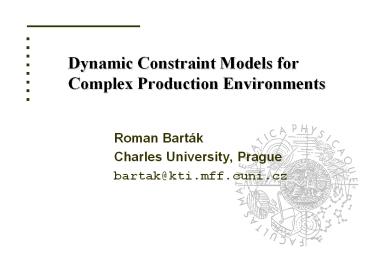Dynamic Constraint Models for Complex Production Environments - PowerPoint PPT Presentation
Title:
Dynamic Constraint Models for Complex Production Environments
Description:
Dynamic Constraint Models for Complex Production Environments Roman Bart k Charles University, Prague bartak_at_kti.mff.cuni.cz – PowerPoint PPT presentation
Number of Views:78
Avg rating:3.0/5.0
Title: Dynamic Constraint Models for Complex Production Environments
1
Dynamic Constraint Models forComplex Production
Environments
- Roman Barták
- Charles University, Prague
- bartak_at_kti.mff.cuni.cz
2
Talk Schedule
- Problem area
- Mixing Planning Scheduling
- Conceptual Models
- discrete event based time
- static vs. dynamic representation
- overview comparison of models
- mixing models
- Future research
3
Problem area
- complex production environments
- plastic, petrochemical, chemical, pharmaceutical
industries - several different resources
- producers, movers, stores
- batch/serial processing with time windows
- transition patterns (set-up times)
- by-products, co-products (re-cycling)
- non-ordered production (for store)
- alternatives
- processing routes, production formulas, raw
material
4
Problem area (contd)
- complex production environment
- Task
- preparing a schedule for a given time period(not
minimising the makespan) - objective
- maximising the profit (minimising the cost)
silo
order
processor B1
silo
purchase
processor A
sacks warehouse
processor B2
order
5
Planning and Scheduling
- Planning
- finding a sequence of activities transferring the
initial world into a required state - high-level view of the factory
- low resolution
- longer time period
- what and how to produce?
- AI CP
- Scheduling
- allocating the activities to available resources
over time respecting the constraints - low-level view of the factory
- high resolution
- shorter time period
- how to produce in detail?
- OR CP
6
Mixing Planning and Scheduling
- Problems
- too tighten plans (impossible to schedule)
- too free plans (less profitable schedule)
- backtrack from the scheduler to the planner
- what if appearance of the activity depends on the
allocation of other activities? - transition patterns (set-ups), alternatives,
non-ordered production - Solution
- a scheduler with planning capabilities
- generating activities during scheduling
7
Conceptual models
- High-level declarative model of the problem
- data structures (composition of variables)
- composition of constraints
- resource constraints (compatibility, capacity)
- transitions between activities (set-ups)
- supplier/consumer dependencies
- Expressiveness
- What could be modelled? (problem area)
- What is easy/hard to express? (constraints)
- Efficiency
- constraint propagation
8
Conceptual models (contd)
- View of time
- discrete (time slices with the same duration)
- event-based (activities)
- Representation
9
Time-line model
- discretising the time line into time slices
- activities change at the edge between successive
time slices - duration the greatest common divisor of
activities duration - description of situation at each time point/slice
- Example the store - the stored quantity for each
item - good for both planning and scheduling
- activities for given time point/slice are chosen
during scheduling - a matrix representation (description x time)
- static / dynamic / semi-dynamic contents of the
cells - easy capture of initial future situations
10
Order-centric model
- a chain of activities per order
- assigning resources to activities
- description of the activity
- start, end (duration), resource
- representation
- production chain a list of (virtual) activities
slots
candidate activities
11
How to model? (in order-centric model)
- alternatives
- pre-processing (chosen by the planner)
- alternative activities in slots
- set-ups
- set-up slot is either empty or contains the
set-up activity (depending on the allocation of
the next activity) - by-products (re-cycling)
- sharing activities between the production chains
- non-ordered production
- pre-processing (non-ordered production is planned
in advance - before the scheduling)
12
Resource-centric model
- Activity based
- a sequence of activities per resource
- what the resource can process rather than how
to satisfy the order - description of the activity
- start, end (duration), quantities, state,
suppliers, consumers - representation
- a list of virtual activities
- transition constraints between successive
activities
13
Comparison of models
14
Mixing the models
- Minimising drawbacks while preserving advantages
of different models - different task different model
- the time-line model for planning
- the order-centric model for scheduling
- different resource different model
- producer mover - activities (resource-centric)
- store - time-line
15
Whats next?
- constraint model
- a complete specification of the constraints
- implementation
- propagation (early detection of inconsistencies)
- labelling (incremental)
- heuristics (choice of alternatives)
- expressiveness
- secondary resources
- traceability
- agent based scheduling































